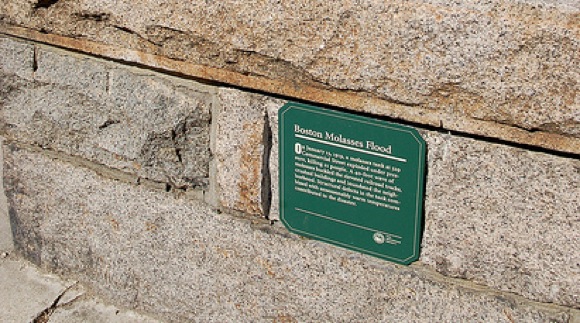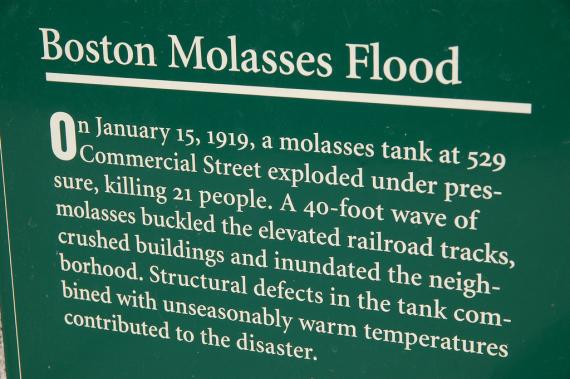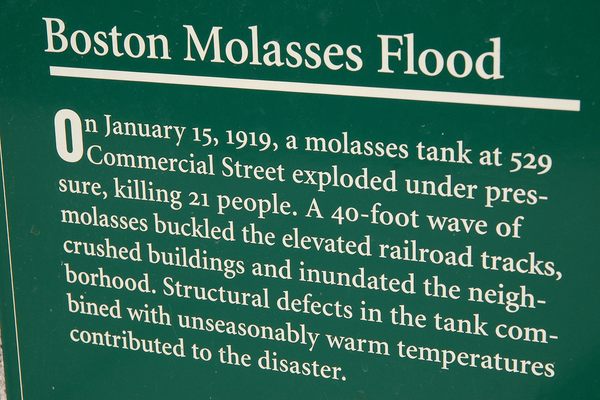Morbid Monday: Sweet Death

Boston is a town known for its history.
From the Paul Revere House to Faneuil Hall the red freedom trail winds through the city’s historic past. However, not all (in fact, not most) of Boston’s interesting history can be found on the red trail.
At the intersection of Foster and Commercial street in Boston’s industrial north end, off the well-traveled trail, there is a interesting, if little visited, historical site. Marked by – one could hardly call it a plaque – marked by a sign is the location a piece of Boston history that is without a doubt one of the oddest things to ever happen… possibly anywhere. It is the site of one of the world’s strangest disasters, The Great Boston Molasses Flood.
At 12:45 on an unusually warm January 15th, 1919 Boston Police Patrolman Frank McManus shouted into his police transmitter. He could barely believe the words that he was saying, “Send all available rescue vehicles and personnel immediately- there’s a wave of molasses coming down Commercial Street!”
A metal tank five stories high, 90 feet in diameter, and containing 2.3 million gallons of molasses had burst. A two-story-tall wave of molasses issued forth, traveling out from the circular tank in all directions like a shock-wave. Oh, and that thing about “slow as molasses,” not so much - the molasses was traveling at an estimated 35 miles per hour. It wasn’t just huge wave of molasses to worry about either, the tank ripped into sharp projectiles and shot the metal bolts from its sides like bullets. It was a bad day to be in Boston’s north end.
As the wave and debris crashed down Commercial Street, buildings were smashed to bits. Entire buildings were picked up by their foundations and floated in the molasses.
Men working in basements were suddenly drowned in molasses, grandmothers napping in first floor houses likewise. Molasses filled eyes, mouths, lungs and most who died, died of suffocation, trapped in the molasses like insects in amber. One man was lucky enough to be swept all the way into the harbor where he was picked up by a passing tugboat, but most were not. An entire company of firefighters were trapped in their crushed firehouse. A father watched as his child was swallowed up in the wave, never to be seen again.
Molasses covered everything and everyone. According to a Boston Post article “Horses died like so many flies on sticky fly paper.” It wasn’t just horses who died. The great Boston molasses flood killed 21 people. The 1919 Boston Post summed it up well: “There was no escape from the wave. Human and animal alike could not flee. To be snared in its flood was to be stifled.”
Though the disaster was first blamed on Italian anarchists, it was in fact the tank company’s fault. The tank, which stored the molasses (destined not for pancakes but as industrial alcohol for munitions), was not nearly strong enough, and it was only a matter of time before it burst. It took years of litigation but the company was eventually found guilty and forced to pay a million dollar settlement. It took over 87,000 man hours to remove the molasses from the surrounding streets and houses, and the area was said to have remained sticky to the touch and sweet to the smell for years afterward. While the molasses flood took many lives and destroyed a neighborhood in Boston’s north end you would never know it today, save for a flimsy little sign on Commercial street. Despite its lack of grandeur, it is a sign worth seeking out, for no other reason than to stand and contemplate what was possibly America’s strangest disaster, The Great Boston Molasses Flood.
As curious as the Molasses Flood is, it was the second recorded food flood disaster. It precedes the Molasses Flood by a little over a hundred years, though it follows an oddly similar story. In 1814, the Meux and Company Brewery had a massive tank built to hold its fermenting beer. At 20 feet high, the tank held 3,555 barrels worth of beer, but on October 17th, 1814 the beer barrel burst open, causing it to break open 3,600 other smaller barrels around it, and releasing a torrent of over a million liters of beer into the streets of London.
Before the Great Boston Molasses Flood, there was the London Beer Flood. A similar story ensues as houses were destroyed and children were swept away by the river of beer. As the beer filled the streets of Totenham Court Road, one of London’s poorest neighborhoods, so did the neighbors with glasses, buckets and anything that could hold beer in hand. Patients in a nearby hospital smelled the beer and demanded their own pints. The final death count from the flood was nine.
Eight from drowning and injuries…and one from alcohol poisoning.
For more on the Molasses Flood try the wiki or better yet, the excellent book “Dark Tide” which is entirely about the flood and the ensuing trial. I also have to give credit to the amazing zine “Murder can be Fun” which turned me on to the wonders of the molasses flood long before there was a wikipedia.
PAY YOUR RESPECTS AT THE…ER, SIGN
 |
GREAT BOSTON MOLASSES FLOOD PLAQUE Site of one of the strangest disasters in history: a wave of deadly molasses traveling at 35 mph.
|
Morbid Mondays highlight macabre stories from around the world and through time, indulging our morbid curiosity for stories from history’s darkest corners. Read more Morbid Mondays>
Join us on Twitter and follow our #morbidmonday hashtag, for new odd and macabre themes: Atlas Obscura on Twitter




Follow us on Twitter to get the latest on the world's hidden wonders.
Like us on Facebook to get the latest on the world's hidden wonders.
Follow us on Twitter Like us on Facebook